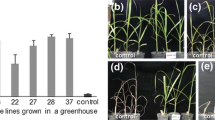Summary
The progeny of 104 regenerated maize plants were screened for tolerance to the safe broad-spectrum herbicide glyphosate during seed germination and early growth. Seven somaclones showed varying degrees of resistance to the application of the herbicide at 1.2 mM (0.1 kg a.i. in 400 1 ha-1 of water). Plants capable of a normal growth following treatment with 2.4 mM (0.2 kg ha-1) glyphosate at the three leaf stage were selfed, and their progeny analyzed. A family able to tolerate the exposure to glyphosate at 2.4 mM was isolated and shown to maintain a photosynthetic rate comparable with control after the application of the herbicide.
The selfed progeny of the tolerant somaclone was characterized as to the properties of two targets of glyphosate, the shikimate pathway enzymes 5-enol-pyruvyl-shikimate-3-phosphate (EPSP) synthase and 3-deoxy-D-arabino-heptulosonate-7-phosphate (DAHP) synthase. In vitro tests ruled out the possibility that the tolerance was due to altered forms of these enzymes. Families showed significant variability with regard to EPSP and DAHP synthase levels, measured at different stages during seedling growth; however, not even these traits were correlated with in vivo response to glyphosate. The possible role of other physiological processes in determining the increased tolerance to the herbicide is discussed.
Similar content being viewed by others
Abbreviations
- DAHP:
-
3-deoxy-D-arabino-heptulosonate-7-phosphate
- EPSP:
-
5-enol-pyruvyl-shikimate-3-phosphate
- CER:
-
carbon-exchange rate
- ID50 :
-
concentration causing 50% inhibition
References
Armstrong, C.L. & C.E.Green, 1985. Establishment and maintenance of friable, embryogenic maize callus and the involvement of L-proline. Planta 164: 345–347.
Bradford, M.M., 1976. A rapid and sensitive method for the quantitation of microgram quantities of protein utilizing the principle of protein-dye binding. Anal. Biochem. 72: 248–254.
Canal, M.J., B.Fernandez & R.Sanchez Tamès, 1985. Effects of glyphosate on growth and the clorophyll and carotenoid levels of yellow nutsedge (Cyperus esculentus). Weed Sci. 33: 751–754.
Cañal, M.J., R.Sanchez Tamès & B.Fernandez, 1987. Glyphosate-increased levels of indole-3-acetic acid in yellow nutsedge leaves correlated with gentisic acid levels. Physiol. Plant. 71: 384–388.
Cañal, M.J., R.Sanchez Tamès & B.Fernandez, 1988. Peroxidase and polyphenol oxidase activities in Cyperus esculentus leaves following glyphosate application. Physiol. Plant. 74: 125–130.
Cañal, M.J., R.Sanchez Tamès & B.Fernandez, 1990. Glyphosate action on abscisic acid levels, stomatal response and electrolyte leakage in jellow nutsedge leaves. Plant Physiol. Biochem. 28: 215–220.
Cole, D.J., 1985. Mode of action of glyphosate-a literature analysis. In: E.Grossbard & D.Atkinson (Eds.), The herbicide glyphosate, pp. 48–74, Butterworths, London.
Coggins, J.R., M.R.Boocock, S.Chauduri, J.M.L.Lambert, J.Lumsden, G.A.Nimmo & D.D.S.Smith, 1987. The arom multifunctional enzyme from Neurospora crassa. Methods in Enzymology 142: 325–338.
Evans, D.A. & W.R.Sharp, 1983. Single gene mutations in tomato plants regenerated from tissue culture. Science 221: 949–951.
Forlani, G. & M.L. Racchi, 1995. Glyphosate tolerance in maize (Zea mays L.). 1. Differential response among inbred lines. Euphytica, in press.
Forlani, G., E.Nielsen & M.L.Racchi, 1992. A glyphosate-resistant 5-enol-pyruvyl-shikimate-3-phosphate synthase confers tolerance to a maize cell line. Plant Sci. 85: 9–15.
Ganson, R.J., T.A.D'Amato & R.A.Jensen, 1986. The two-isozyme system of 3-deoxy-D-arabino-heptulosonate 7-phosphate synthase in Nicotiana silvestris and other higher plants. Plant Physiol. 82: 203–210.
Hollander-Czytko, H. & N.Amrhein, 1983. Subcellular compart-mentation of shikimic acid and phenylalanine in buckwheat cell suspension cultures grown in the presence of shikimate pathway inhibitors. Plant Sci. Lett. 29: 89–96.
Kishore, G., S.R.Padgette & R.T.Fraley, 1992. History of herbicide tolerant crops, methods of development and current state of the art. Emphasis on glyphosate tolerance. Weed Techn. 6: 626–634.
Kitchen, L.M., W.W.Witt & C.E.Rieck, 1981. Inhibition of δ-aminolevulinic acid synthesis by glyphosate. Weed Sci. 29: 571–577.
Larkin, P.J. & W.R.Scowcroft, 1981. Somaclonal variation—a novel source of variability from cell cultures for plant improvement. Theor. Appl. Genet. 60: 197–214.
Lemerle, D. & R.D.Cousens, 1993. Influence of growth stage on spring barley (Hordeum vulgare) tolerance to chlorsulfuron. Weed Sci. 41: 127–132.
Mazur, B.J. & S.C.Falco, 1989. The development of herbicide resistant crop. Annu. Rev. Plant Mol. Biol. 40: 441–470.
Moore, S., 1968. Aminoacid analysis: aqueous dimetyl sulphoxide as solvent for the ninhydrin reaction. J. Biol. Chem. 243: 6281–6283.
Mousdale, D.M. & J.R.Coggins, 1985. High-performance liquid chromatography of shikimate pathway intermediates. J. Chromatogr. 329: 268–272.
Rajasekaran, K., M.B.Hein & I.K.Vasil, 1987. Endogenous abscisic acid and indole-3-acetic acid and somatic embryogenesis in cultured leaf explants of Pennisetum purpureum Schum. Plant Physiol. 84: 47–51.
Rubin, J.L., C.G.Gaines & R.A.Jensen, 1982. Enzymological basis for herbicidal action of glyphosate. Plant Physiol. 70: 833–839.
Scowcroft, W.R. & P.J.Larkin, 1988. Somaclonal variation, cell selection and genotype improvement. In: Comprehensive Biotechnology, Vol. 1, pp. 153–168, Pergamon Press, Oxford.
Sellin, C., G.Forlani, J.Dubois, E.Nielsen & J.Vasseur, 1992. Glyphosate tolerance in Cichorium intybus L. var. Magdebourg. Plant Sci. 85: 223–231.
Shaner, D.L., T. Malefyt & P. Anderson, 1985. Herbicide-resistant maize through cell culture selection. In: Copping, L.G. & P. Rodgers (Eds.), BCPC Monograph 32: Biotechnology and its application to agriculture, pp. 45–50, British Crop Protection Council.
Snedecor, G.W. & W.G.Cochran, 1967. Pages 159–160. In: Statistical methods. Sixth Edition. The Iowa State University Press, Ames, Iowa.
Srinivasan, P.R. & D.B.Sprinson, 1959. 2-keto-3-deoxy-D-arabo-heptonic acid 7-phosphate synthetase. J. Biol. Chem. 234: 716–722.
Steinrücken, H.C. & N.Amrhein, 1980. The herbicide glyphosate is a potent inhibitor of 5-enolpyruvyl-shikimic acid-3-phosphate synthase. Biochem. Biophys. Res. Commun. 94: 1207–1212.
Turner, D.J., 1985. Effects on glyphosate performance of formulation, additives and mixing with other herbicides. In: E.Grossbard & D.Atkinson (Eds.), The herbicide glyphosate, pp. 221–240, Butterworths, London.
Author information
Authors and Affiliations
Rights and permissions
About this article
Cite this article
Racchi, M.L., Rebecchi, M., Todesco, G. et al. Glyphosate tolerance in maize (Zea mays L.). 2. Selection and characterization of a tolerant somaclone. Euphytica 82, 165–173 (1995). https://doi.org/10.1007/BF00027063
Received:
Accepted:
Issue Date:
DOI: https://doi.org/10.1007/BF00027063




